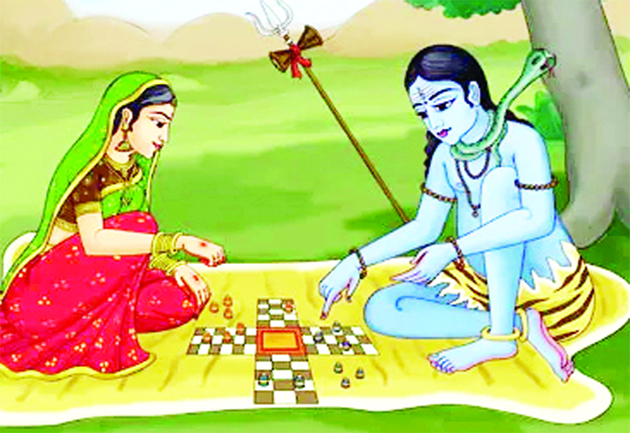Anil Paba
World Heritage Day is celebrated every year on April 18 to spread awareness of our rich cultural diversity and importance of preserving our ancient heritage. The purpose of celebrating this date is to share an important message to the younger generations to carry their legacy and preservation of culture.
World Heritage Day
April 18 as the international Day for Monuments and Sites, followed by UNESCO adoption during its 22nd General Conference. Each year, on this occasion, ICOMOS proposes a theme for activities to be organized by its members, National and International Scientific Committees, partners, and any one who wants to join in making the Day.
Recent, discovery of an ancient game by the author popularly known as Choupad/ Chausar from a remote village namely Kotlibala of District Udhampur engraved on a megalithic stone having size 37″*35″ adds new chapter in the history of Madrardesha (Duggar). Sometimes back author visited the village along with Sunil Singh, Vikas Gupta, Sarpanch Nisha Devi and Naib Sarpanch Subash Chander for historical tour of the said village and discovered the traditional game played with Cowries shell and dice. Archaeologically it is an important discovery and more research could lead to dating and perspective of the carving.
The Rig Veda has references to the use of dice and one of its Hymns is a charm to cure unsuccessful gamblers of the compulsion to gamble that has ruined him. In the Atharva Veda also gambling with dice is mentioned.
At Mohenjodaro in the Indus valley a portion of a triple-rowed gaming diagram on brick was recovered dating perhaps from the last part of the 3rd millennium B.C. The use of cowries is also as old in India as the Harappan civilization of the 3rd millennium B.C. Such types of engraving on board games have also been discovered from many temples, caves and forts of India.
In the great epic Mahabharata It is known as Dyuta Krida), the game that was played between Kauravas and Pandavas, where Draupadi was put on stake. The game was then reserved for kings and princes and there were no rules on the minimum bet. Pandavas played this game because the eldest one, Yudhishitra, loved the game. Also, it was considered rude to turn down the invitation of another King/Prince.
Chousar is generally constructed of cloth having dimension 32″*32″, six cowry shells are thrown to determine the moves, and the counter are made of Rose wood in a beehive shape. It is generally believed that the Chousar has been created by Mahadev. A famous natya geeta is in Mythological Marathi drama where Shiva and Parvati played the game and Narada Muni sings the song.
However, thereafter it was called Sari pat or Sari patt also game of gambling and amusement but now played by kings and traders or common folk. The temple of goddess also have many legends about the Sari pat play of goddess in particular Tuljabhavani temple in Tuljapur( Maharashtra).
Likewise Chaupar, Chopad or Chaupad is a cross and circle board game very similar to Pachisi, played in India. The board is made of woolen or cloth, with wooden Pawns and seven Cowry shells to be used to determine each player’s move, although others distinguish Chaupar from Pachisi by the use of three-four sided long dice. Variations are played throughout India.
In north India it is known as Chaupad. It was played by lay people and all levels of society for thousands of years. In most of the villages of Punjab, Haryana, Rajasthan, Jammu and Kashmir, this game is played by old persons. Locally it is also known as Ram Chowki, Choukad bazzi in Dogri and played with geeties and this practice still in use. During winter and rainy season the local people are forced to stay at home and they generally play this game. According to Prof Shiv Dutt Nirmohi (Padamshree), the Yog Guru of Maharaja Partap Singh namely Swami Nityanand Swami was also fond of this game.
Other games that were popular like’ Nava-Navri (Bride and Groom), Nava Kankari (Nine- Men’s -Morris), Bhedi-Bakri Goats and sheep), Sharo Vyuha Arrowhead) and four seed Mocala.
In Uttrakhand Choupar is played with wooden dice and seven cowries. Two or four players can play and it is made by knitting cloth. In Jabalpur it is known as Choukhete wala game” Kanna-Goti” with the help of (IMLI-SEED). In Kannada this game is known as Pagadeyata and Saripat in Marathi, which was played by one to eight players a side with cowries. Pachees in Telgu and Thaayam game very much popular in Tamilnadu is played for the purpose of getting rain.
It becomes our moral duty to preserve our traditional games also like other heritage. We must organize various programs for the study and dissemination of ancient and medieval games. For this we must start workshops and Mega- Exhibition to promote these with the help of Archaeological Survey of India (ASI), INTACH and Universities.
Instucen (India-Study- Centre) has already organized conferences, site-seminars and workshops in Indian archaeology and anthropology, undertakes research projects including explorations and excavations, restoration and conservation projects in all the spheres of Indian history and culture with international and governmental assistance.
The main purpose of the INSTUCEN TRUST is to preserve and promote this intangible tradition. The trust encourages its associates and volunteers to find these games, document them and bring them to the public’s information, so that this aspect of our intangible heritage is not lost.
(The author is Director Amar Santosh Museum, Udhampur, Member Intach Chapter Jammu)
feedbackexcelsior@gmail.com


